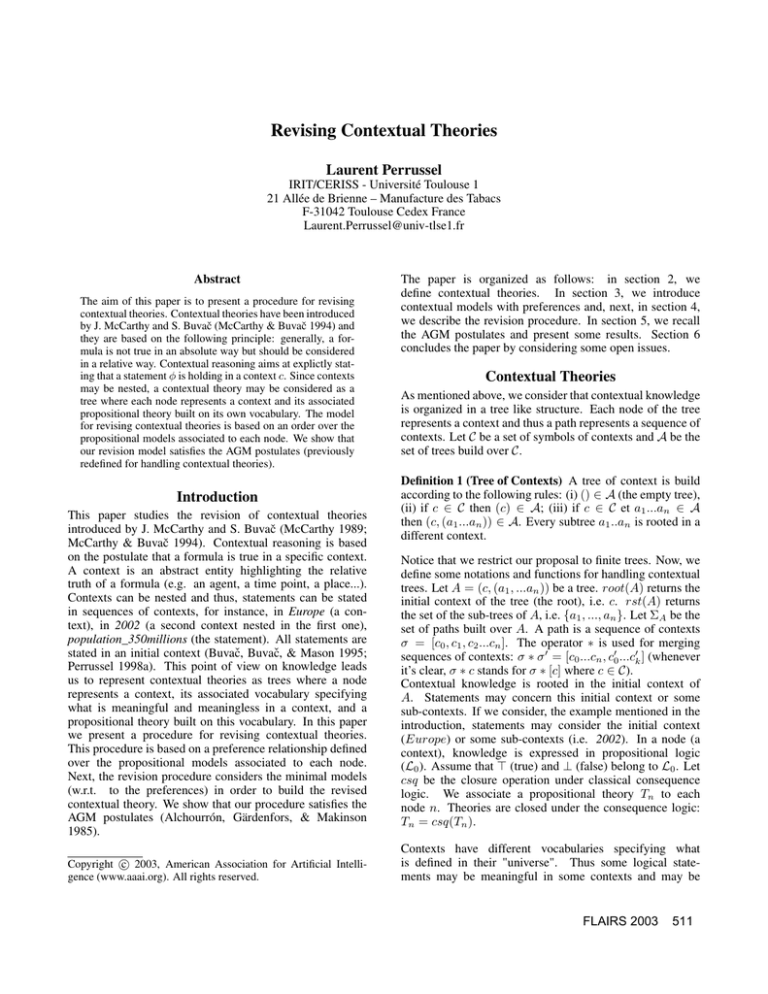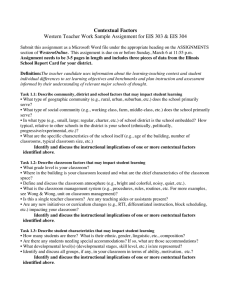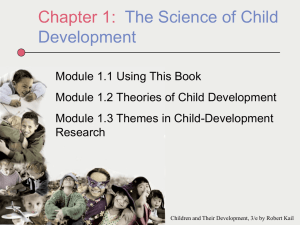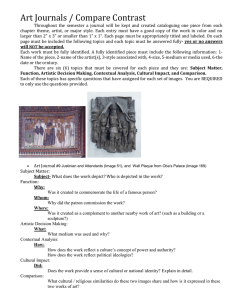
Revising Contextual Theories
Laurent Perrussel
IRIT/CERISS - Université Toulouse 1
21 Allée de Brienne – Manufacture des Tabacs
F-31042 Toulouse Cedex France
Laurent.Perrussel@univ-tlse1.fr
Abstract
The aim of this paper is to present a procedure for revising
contextual theories. Contextual theories have been introduced
by J. McCarthy and S. Buvač (McCarthy & Buvač 1994) and
they are based on the following principle: generally, a formula is not true in an absolute way but should be considered
in a relative way. Contextual reasoning aims at explictly stating that a statement φ is holding in a context c. Since contexts
may be nested, a contextual theory may be considered as a
tree where each node represents a context and its associated
propositional theory built on its own vocabulary. The model
for revising contextual theories is based on an order over the
propositional models associated to each node. We show that
our revision model satisfies the AGM postulates (previously
redefined for handling contextual theories).
Introduction
This paper studies the revision of contextual theories
introduced by J. McCarthy and S. Buvač (McCarthy 1989;
McCarthy & Buvač 1994). Contextual reasoning is based
on the postulate that a formula is true in a specific context.
A context is an abstract entity highlighting the relative
truth of a formula (e.g. an agent, a time point, a place...).
Contexts can be nested and thus, statements can be stated
in sequences of contexts, for instance, in Europe (a context), in 2002 (a second context nested in the first one),
population_350millions (the statement). All statements are
stated in an initial context (Buvač, Buvač, & Mason 1995;
Perrussel 1998a). This point of view on knowledge leads
us to represent contextual theories as trees where a node
represents a context, its associated vocabulary specifying
what is meaningful and meaningless in a context, and a
propositional theory built on this vocabulary. In this paper
we present a procedure for revising contextual theories.
This procedure is based on a preference relationship defined
over the propositional models associated to each node.
Next, the revision procedure considers the minimal models
(w.r.t. to the preferences) in order to build the revised
contextual theory. We show that our procedure satisfies the
AGM postulates (Alchourrón, Gärdenfors, & Makinson
1985).
c 2003, American Association for Artificial IntelliCopyright gence (www.aaai.org). All rights reserved.
The paper is organized as follows: in section 2, we
define contextual theories. In section 3, we introduce
contextual models with preferences and, next, in section 4,
we describe the revision procedure. In section 5, we recall
the AGM postulates and present some results. Section 6
concludes the paper by considering some open issues.
Contextual Theories
As mentioned above, we consider that contextual knowledge
is organized in a tree like structure. Each node of the tree
represents a context and thus a path represents a sequence of
contexts. Let C be a set of symbols of contexts and A be the
set of trees build over C.
Definition 1 (Tree of Contexts) A tree of context is build
according to the following rules: (i) () ∈ A (the empty tree),
(ii) if c ∈ C then (c) ∈ A; (iii) if c ∈ C et a1 ...an ∈ A
then (c, (a1 ...an )) ∈ A. Every subtree a1 ..an is rooted in a
different context.
Notice that we restrict our proposal to finite trees. Now, we
define some notations and functions for handling contextual
trees. Let A = (c, (a1 , ...an )) be a tree. root(A) returns the
initial context of the tree (the root), i.e. c. rst(A) returns
the set of the sub-trees of A, i.e. {a1 , ..., an }. Let ΣA be the
set of paths built over A. A path is a sequence of contexts
σ = [c0 , c1 , c2 ...cn ]. The operator ∗ is used for merging
sequences of contexts: σ ∗ σ = [c0 ...cn , c0 ...ck ] (whenever
it’s clear, σ ∗ c stands for σ ∗ [c] where c ∈ C).
Contextual knowledge is rooted in the initial context of
A. Statements may concern this initial context or some
sub-contexts. If we consider, the example mentioned in the
introduction, statements may consider the initial context
(Europe) or some sub-contexts (i.e. 2002). In a node (a
context), knowledge is expressed in propositional logic
(L0 ). Assume that (true) and ⊥ (false) belong to L0 . Let
csq be the closure operation under classical consequence
logic. We associate a propositional theory Tn to each
node n. Theories are closed under the consequence logic:
Tn = csq(Tn ).
Contexts have different vocabularies specifying what
is defined in their "universe". Thus some logical statements may be meaningful in some contexts and may be
FLAIRS 2003
511
meaningless in others. Let P be the set of propositional
symbols and V oc : ΣA → 2P be a function specifying the
vocabulary associated to a node. We assume that and ⊥
belong to all vocabularies (∀σ ∈ ΣA ({, ⊥} ⊆ V oc(σ))).
In order to define if a formula is meaningful or meaningless
in a sequence of contexts, we introduce a function Voc:
for every propositional formula φ, Voc returns the set of
propositional symbols appearing in φ: Voc : L0 → 2P .
Thus, a contextual theory is a set of propositional
statements defined on a specific vocabulary and a set of
statements about other contexts. This set is in fact a set of
"sub"-contextual theories.
Definition 2 (Contextual Theory) A contextual theory K
defined over a tree of contextsA and rooted in an initial sequence σ is a couple Γ, a∈rst(A) {Ka } such that
Γ ∈ 2L0 , Voc(Γ) ⊆ V oc(σ ∗ root(A)) and every Ka is a
contextual theory rooted in the sequence σ ∗ root(A).
Let A be a tree of contexts. We consider a special
contextual theory A where every propositional theory
is equivalent to true. let A be this theory such that
A = , ∪a∈rst(A) {a }. In order to merge two theories,
we consider a union-like operator. Let be the union
of two contextual theories associated to a tree A. If
K = Γ0 , ∪a∈rst(A) Ka and
Ka then
K = Γ0 , ∪a∈rst(A)
K K = csq(Γ0 ∪ Γ0 ), a∈rst(A) {Ka Ka }. We use
the symbol for describing the inclusion of a first theory in
a second one: K K ⇐⇒ ∃K (K K = K ).
After describing contextual theories in a syntactic way,
we consider their semantics. Considering a contextual
approach in the semantics means that only a subset of
the propositional symbols set P may be valued (Buvač,
Buvač, & Mason 1995). A contextual model is a tree where
we associate to every node a set of propositional truth
assignments.
Definition 3 (Contextual Model) Let MA = W, ∪a ∈
rst(A){Ma } be a contextual model associated to a tree of
contexts A such that W is a set of propositional truth assignments w : P → {1, 0} where w could be partial and a set of
contextual models (a contextual model for each sub-tree). If
w ∈ W , Dom(w) returns the range of w: a subset of P.
We say that a contextual model M = W, ∪{Ma } is
included in a model M = W , ∪{Ma }, M ⊆ M , iff
the set W is included or is equal to the set W and every
sub-contextual model Ma is included in Ma (Ma ⊆ Ma ).
Let A be a tree of contexts, a contextual theory
Γ, a∈rst(A) {Ka } is satisfied by a contextual model
W, ∪a ∈ rst(A){Ma } if the propositional theory Γ is
satisfied and if all the sub-theories Ka are satisfied by their
respective contextual models Ma . More formally (|=L0
stands for the propositional satisfaction relation):
512
FLAIRS 2003
Definition 4 (|=) Let A be a tree of contexts, V oc its associated vocabulary, σ an initial sequence of contexts and
MA = W, Ω a contextual model (Ω represents the set of
nested models). Let w ∈ W be a propositional truth assignment and KA be a contextual theory satisfying the vocabulary constraints mentioned in the definition 2. The relationship M, w |= K is defined if
1. Voc(Γroot(A) ) ⊆ Dom(w),
2. the relationship |= is defined for all the nested models
Ma ∈ Ω.
If M, w |= K is defined, MA , w |= K holds iff:
1. w |=L0 Γroot(A) and
2. for every model Ma = Wa , Ωa ∈ Ω, every world wa ∈
Wa , we get Ma , wa |= Ka .
In other words, if the relationship |= is not defined w.r.t. to
the vocabulary constraints, then neither MA , w |= KA and
MA , w |= KA are defined.
Revision Contextual Model
As A. Grove (Grove 1988), we adopt a revision function
based on a semantical approach. The procedure is based
on a set of preferences. Defining an order, when we have a
semantical point of view, consists of specifying preferences
over valuations. Let ≤ be the relationship describing preferences over propositional valuations. The notation w ≤ w
means that the plausibility of w is better than or equal to the
plausibility of w . We assume that ≤ is reflexive and transitive. The relationship ≤ is defined for every sequences of
contexts since preferences are specific to each contexts. Let
us mention that we can only compare valuations belonging
to the same set of valuations.
Definition 5 (Revision Model) A revision model Mr associated to a tree A is a structure W, ≤, ∪a∈rst(A) {Mar }
where W is a set of valuations, ≤ a preorder and
∪a∈rst(A) {Mar } a set of revision models.
A revision models is a tree of ordered valuations. Our revision function will be based on those pre-orders. Based on
a revision model and the preferred valuations associated to
each sequence of contexts, we build the tree of minimal valuations. Let us call this resulting contextual model, a contextual minimal model.
Definition 6 (Contextual minimal model: M) Let M r =
W, ≤, ∪a∈rst(A) {Mar } be a contextual revision model.
The minimal contextual model based on Mr is a contextual
model defined as:
{w ∈ W | for all w ∈ W, w ≮ w}, ∪a∈rst(A) {Ma }
As usual, w < w stands for w ≤ w and w ≤ w. The
next stage consists of linking a theory and a contextual revision model. Let K be a contextual theory and Mr a revision
model. Assume the following constraints. First of all, the
minimal contextual model based on Mr satisfies K, i.e. the
most plausible valuations are those that are verifying their
w2
w3
k
w1
k
?w1
k
@
R
@
@
I
R
@
k
- kw4
w3
≤c0
=
W, ≤, a∈rst(A) {Mar } a complete reMr
vision model for a contextual theory K and
K = Γroot(A) , a∈rst(A) Ka a contextual theory.
Let min(K ) be the minimal contextual model based on
Mr satisfying K .
In order to define min(K ), we consider all the minimal
valuations in every sequence of contexts. Let |W |min(K )
be the set of minimal truth assignments belonging to W and
satisfying Γroot(A) :
kw2
?
k
- kw4
≤c0 ∗c1
Figure 1: Pre-orders of the revision model M r described in
(2).
|W |min(K ) = {w ∈ W |w |=L0 Γroot(A) and
for all w ∈ W if w < w then w |=L0 Γroot(A) }
associated propositional theory. Next, we constrain the preorders such that every relationship ≤ is connected, i.e. for
all w, w ∈ W , either w ≤ w or w ≤ w stands. Let |W |M
be the set of minimal valuations belonging to W . Every possible valuations, w.r.t. the vocabulary specified by V oc has
to be defined. Let Wσ be the set of all possible valuations
build on the vocabulary V oc(σ).
Definition 7 (Complete revision model) Let A be a contextual tree, σ an initial sequence of contexts and MAr =
W, ≤, ∪a∈rst(A) {Mar } a revision model. A revision model
Mr is said to be a complete for a contextual theory KA iff:
• W = Wσ∗root(A) , i.e. all the valuations build on V oc(σ ∗
root(A)) belongs to W ,
• The relation ≤ is transitive, reflexive and connected.
• for all w, w ∈ |W |M iff M, w |= K.
• every revision model Mar is a complete revision model
rooted in the initial sequence σ ∗ root(A).
For instance, let us consider the following contextual tree
A = (c0 , (c1 )), the empty initial sequence σ = [] and the
contextual theory build on A and rooted in σ (V oc([c0 ]) =
V oc([c0 , c1 ]) = {p, q}):
K = {p → q}, {{p, p ∨ q}, ∅}
(1)
Assume the following revision model:
M r = {w1 , w2 , w3 , w4 }, ≤c0 ,
{{w1 , w2 , w3 , w4 }, ≤c0 ∗c1 , ∅} (2)
According to this definition, min(K ) is a contextual model
defined as follows:
min(K ) = |W |min(K ) , ∪a∈rst(A) {min(Ka )}
We get a similar definition, when we consider all the valuations (and thus without considering the preferenceces): let
|W |K be the set of propositional truth assignments satisfy
ing Γroot(A) :
|W |K = w ∈ W |w |=L0 Γroot(A)
As for min(K ) we get the contextual model K based on
Mr and satisfying K :
K = |W |K , ∪a∈rst(A) {Ka }
Let us notice that min(K ) and K will be defined if and
only if vocabulary constraints are not violated (cf. definition
2).
The Revision Procedure
Revising a contextual theory K built on a contextual tree A
consists of revising the propositional theories. The smallest
revision step is to change only one propositional theory belonging to K. In order words, the input of a revision is a
propositional formula φ and a sequence of contexts σ ∈ ΣA
describing which propositional theory should be revised.
The first stage of the revision procedure is to map the structure σ, φ to a contextual theory k (σ = [c0 , c1 , c2 ...cn ]):
k = , {... , {... {φ}, {...} ...} ...}
Valuations are: w1 = {p̄, q̄}, w2 = {p̄, q}, w3 = {p, q̄} et
w4 = {p, q} where p̄ means wi (p) = 0. The pre-orders ≤c0
et ≤c0 ∗c1 are described figure 1 where wi → wj stands for
wj ≤ wi . The model is complete and we have the minimal
model ={w1 , w2 , w4 }, {{w3 , w4 }, ∅}.
i.e. k is a contextual theory where every propositional theory
is defined as equal to except the theory associated to the
sequence σ. If k is a contextual theory for A, i.e., k do not
violate the vocabulary constraints described by V oc, then
the revision of K by k and is denoted by Kk∗ .
Now, we can specify our revision function for revising contextual theories.
Our revision function is
based on the works of C. Boutilier (Boutilier 1994;
1995). For revising a theory K by a second theory K , we
extract the minimal models satisfying K from the complete
revision model Mr associated to K.
Definition
8 (*) Let K be a contextual theory and M =
W, ≤, a∈rst(A) {Mar } a complete revision model for K.
Let k = , {... , {... {φ}, {...} ...} ...} be the contextual theory associated to a couple σ, φ. The revision of K
by k is defined as:
Kk∗ =
k
Let A be a contextual tree, σ an initial sequence,
min(k)⊆k FLAIRS 2003
513
where contextual theories k are defined as k: for every
sequence σ = [c0 , c1 , c2 ...cm ] ∈ ΣA and every propositional formula ψ, k is defined as the contextual theory
, {..., {...{ψ}, {...}...}...}.
Theorem 1 Let k be a contextual theory associated to a couple σ, φ. Every complete revision model Mr for a contextual theory K defines the revision of K by k so that the
postulates R1-R8 are satisfied.
Let us consider again the contextual theory described in 1
and its associated revision model (cf. figure 1). Suppose we
revise the propositional theory of the sequence of contexts
[c0 , c1 ]: the statement ¬p have to be incorporated in that
theory. According to our definitions, K have to be revised
by the theory:
k = {}, {¬p}, ∅
Theorem 2 Let Rev be a revision function satisfying the
postulates R1-R8. If Rev(K, k) is the contextual theory resulting of the revision of K by k then for every K and k there
exists a complete revision model Mr such that Rev(K, k) =
Kk∗ .
And we get
Kk∗ =
Linking contextual and propositional theory
revision
k = {p → q}, {q}, ∅
min(k)⊆k Notice that in the resulting theory Kk∗ , only node have been
changed: the node associated to the sequence [c0 , c1 ].
Based on this revision function for basic change we
can easily extend our definition of ∗ for any kind of k.
Since every contextual theory may be redefined as a set of
couples sequence, propositional statement, we just have
to apply the revision function for all the basic couples. The
following stage consists of stating if the revision function
satisfy the AGM postulates.
Properties of the revision model
In order to prove the main properties of the function ∗, we redefine the AGM postulates for contextual theories (Alchourrón, Gärdenfors, & Makinson 1985). Let A be a contextual
tree with a vocabulary specified by V oc. Let K and k be
two contextual theories built on A (and thus satisfying the
vocabulary constraints). The AGM postulates are redefined
as follows:
R1
Kk∗
R2 k We have defined contextual theories in a tree-like structure.
Revision action are considered in a basic way: changing
a propositional theory in a node. Our revision function ∗
ensures us that just one node has been modified. Since ∗
revises only one node, our change function is close to the
functions for revising a set of propositional statements. In
this section, we revisit our revision function by considering
the revision functions for handling propositional theories.
Let σ be the sequence of contexts representing a node.
Let Γσ be the associated propositional theory. Assume a
model Mσ = Wσ , ≤σ defined for every σ. The model
Mσ is similar to the models of revision introduced by
A. Grove (Grove 1988) and C. Boutilier (Boutilier 1994;
1995). If we consider the models of revision presented by
C. Boutilier, a model is a structure MB = W, ≤, ϕ s.t.
• W = Wσ ,
• ≤=≤σ and
• for every symbol p, ϕ(w, p) = wσ (p).
MB satifies the following constraints (Boutilier 1994):
is a contextual theory;
• all the possible worlds are defined,
Kk∗ ;
• ≤ is reflexive, transitive and connected and
R3 Kk∗ Kk+ (s.t. Kk+ = K k);
R4 If ¬k K then Kk+ Kk∗ (if k is a contextual theory associated to σ, φ, then ¬k is the contextual theory
associated to σ, ¬φ);
R5 Kk∗ = Csq(A ) iff |=
csq(), a∈rst(A) a );
¬k (Csq(A )
∗
∗ +
R7 Kkk
(Kk )k ;
∗
R8 If ¬k K then (Kk∗ )+
k Kkk ;
We have the followings theorems. The first one states that
∗ satisfies the redefined AGM postulates and the second one
states that for every revision of a contextual theory, we can
defined a revision model. Theorems are stating for a contextual tree and a vocabulary V oc; contextual theories K and k
are build on a tree A.
FLAIRS 2003
• the minimal worlds, w.r.t. ≤, satisfy Γσ and are the only
ones which satisfy Γσ .
MB is a model for revising propositional theories. Let
RevMB be a revision function for revising a propositional
theory based on MB and satisfying the AGM postulates:
=
R6 If |= k ↔ k then Kk∗ = Kk∗ (k ↔ k iff
(∀M, w)M, w |= k iff M, w |= k );
514
Proofs of the theorems are based on (Perrussel 1998b).
RevMB (Γ, φ) = {ψ|minMB (φ) ⊆ ψMB }
such that minMB (φ) is the set of minimal worlds satisfying φ (w.r.t. ≤) and ψMB is the set of worlds satisfying
ψ. Based on this function, we can reformulate our revision
function1 :
(Γ
,
φ),
{K
}
Rev
M
a
root(A)
B
a∈rst(A)
if
σ
=
root(A)
∗
Kσ,φ
= ∗
Γ
,
{K
}
root(A)
a∈rst(A)
a,σ−root(A),φ
otherwise
1
If σ = [c0 , c1 , ..., cn ] ∈ ΣA then σ − root(A) = [c1 , ..., cn ].
Conclusion
In this article, we have proposed a function procedure for
revising contextual theories organized in a tree-like structure (McCarthy & Buvač 1994; Buvač, Buvač, & Mason
1995). We have defined contextual theories as local propositional theories build on specific vocabularies. In a first stage
we have introduced preferences in contextual models. In a
second stage, we have proposed a revision function which
considers the best elements for revising a contextual theory. We have shown that the revision function satisfies the
AGM postulates. This work is a first step for handling nonmonotonicity in contextual reasoning.
References
Alchourrón, C.; Gärdenfors, P.; and Makinson, D. 1985.
On The Logic of Theory Change: Partial Meet Functions
for Contaction and Revision. Journal of Symbolic Logic
50:510–530.
Boutilier, C. 1994. Unifying Default Reasoning and Belief Revision in a Modal Framework. Artificial Intelligence
68:33–85.
Boutilier, C. 1995. Iterated Revision and Minimal Change
of Conditional Beliefs. Journal of Philosophical Logic. To
appear.
Buvač, S.; Buvač, V.; and Mason, I. 1995. MetaMathematics of Contexts.
Fundamenta Informaticae
23(3):263–301.
Grove, A. 1988. Two Modellings for Theory Change. Journal of Philosophical Logic 17:157–170.
McCarthy, J., and Buvač, S. 1994. Formalizing Context:
Expanded Notes. Technical Report STAN-CS-TN-94-13,
Computer Science Departement - Stanford University.
McCarthy, J. 1989. Artificial Intelligence, Logic and Formalizing Common Sense. Philosophical Logic and Artificial Intelligence.
Perrussel, L. 1998a. Contextual Reasoning. In Prade,
H., ed., Proceedings of the 13th European Conference on
Artificial Intelligence (ECAI ’98), August 23–28, 1998,
Brighton UK, 366–367. John Wiley & Sons, Ltd.
Perrussel, L.
1998b.
Un Outillage Logique Pour
l’Ingénierie des Exigences Multi-Points de Vue. Ph.D. Dissertation, Université Paul Sabatier.
FLAIRS 2003
515





